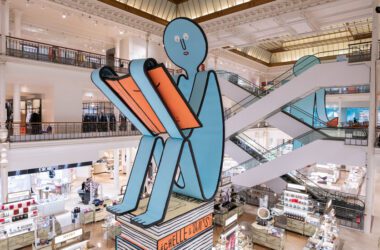Bob Heil’s career as a groundbreaking sound engineer who brought thunder and rich sonic coloring to tours by rock titans like the Grateful Dead and the Who began behind a pipe organ in a 1920s movie palace.
Mr. Heil, who helped usher rock into its arena-shaking era by designing elaborate sound systems that allowed rock juggernauts of the late 1960s and ’70s to play at volcanic volumes, first learned to appreciate the full spectrum of musical tones as a teenager, when he took a job playing the massive Wurlitzer pipe organ at the opulent Fox Theater in St. Louis.
“We had to voice and tune 3,500 pipes, from one inch to 32 feet,” he said in a 2022 video interview with the audio entrepreneur Ken Berger. “Voicing taught me to listen. Very few people know how to listen. Listening, you’ve got to mentally go in and dissect.”
Mr. Heil died on Feb. 28 of cancer in a hospital in Belleville, Ill., his daughter Julie Staley said. He was 83. His death was not widely reported at the time.
Although he worked behind the scenes, Mr. Heil was enough of a force that the Rock & Roll Hall of Fame in Cleveland credited him with “creating the template for modern rock sound systems” In 2006, the Hall installed a public display containing his mixing boards, speakers and other items.
“The concert business became what it is today because he made the experience so much better for the customers,” Howard Kramer, who at the time was the Hall of Fame’s curatorial director, said in an interview that year with The Houston Chronicle. “No one made the leaps in live sound that he did.”
Mr. Heil got started in the business in 1966. Up to that point, top rock ’n’ roll bands often had to rely on feeble sound systems that were drowned out by screaming fans. That roar, Keith Richards of the Rolling Stones wrote in his 2010 autobiography, “Life,” was often so deafening in the band’s early days that audiences could hear nothing more than the drums: “We used to play ‘Popeye the Sailor Man’ some nights, and the audience didn’t know any different.”
Mr. Heil gave rock shows the sound arsenal they needed. “We were the first company back then to build a package P.A.,” he said in a 2008 interview with the audio magazine TapeOp. “You could come to Heil Sound in 1972 and leave the facility with a complete system: snakes, road cases, everything — even a modular mixer.”
He also put a distinctive stamp on 1970s rock with the Heil Talk Box, an effects pedal that transformed guitar parts and vocals into an interstellar drone. Joe Walsh used it in memorable fashion on his hit “Rocky Mountain Way” in 1973, and the Talk Box was a signature of Peter Frampton’s monster-selling 1976 double album, “Frampton Comes Alive!”
Mr. Heil’s career took a major turn in 1971, he told Mr. Berger, when a manager for the Who frantically called him in St. Louis, asking if he could get his crew to Boston the next day. The opening show on the band’s tour in support of its hallowed album “Who’s Next” had been a disaster, with one newspaper noting that the band’s “soaring brand of rock could not be heard” under the venue’s “miserable conditions.”
Roger Daltrey, the band’s lead singer, threatened to fly back to England until Mr. Heil arrived with his rig. When Mr. Daltrey “did the sound check,” Mr. Heil recalled, “it was OK, because it was a monster P.A.” He would work with the Who for the next decade.
Robert Gene Heil was born Oct. 5, 1940, in St. Louis, the elder of two children of Robert and LaVerna (Bills) Heil. His parents owned a clothing shop in the small town of Marissa, Ill., about 40 miles east of St. Louis.
As a youth, Bob not only played the accordion and the organ but also became a ham radio enthusiast, which gave him an early opportunity to fiddle with electronics. After graduating from Marissa Township High School in 1958, he spent time studying at the University of Illinois in Urbana-Champaign and the St. Louis Institute of Music.
In 1966 he opened Ye Olde Music Shop in Marissa, where he rented Hammond organs and repaired instruments for professional musicians. He also began to design his own audio systems.
Before long, he was supplying them to country acts like Dolly Parton and Little Jimmy Dickens as they came through St. Louis. His big break came in 1970, when management of his old employer, the Fox Theater, called him and told them of a crisis: The Grateful Dead was set to play there, but the band’s P.A. system had been confiscated by authorities in a drug raid.
On a subsequent call with Mr. Heil, Jerry Garcia, the band’s lead guitarist and vocalist, “almost dropped the phone” when he learned that Mr. Heil had a sophisticated system featuring an amplifier by McIntosh, the high-end audiophile brand, Mr. Heil told Mr. Berger. Performing Musician magazine later called the resulting concert “the night that modern live sound was born.”
In addition to his daughter Ms. Staley, Mr. Heil is survived by his wife, Sarah (Benton) Heil; another daughter, Barbara Hartley; a stepson, Ash Levitt, the president and chief executive of Heil Sound; a sister, Barbara Schneidewind; and seven grandchildren. Both daughters are from his first marriage, to Judy Mortensen, which ended in divorce.
By 1980, Mr. Heil had grown weary of life on the road, so he created a new line of headsets and microphones for the ham radio industry. At one point, Joe Walsh, another ham enthusiast, told him he wanted to use one of his microphones onstage.
Mr. Heil protested that the microphones were not concert quality. Mr. Walsh disagreed. “I was at his house and went downstairs to his little studio and he proved it to me,” Mr. Heil told TapeOp. “So I had to start listening all over again.”
Source link













This was highly educational. More at ##anyKeyword##
Thanks for the practical tips. More at ##anyKeyword##
Great job! Discover more at ##anyKeyword##
Well explained. Discover more at ##anyKeyword##
Helpful suggestions! For more, visit ##anyKeyword##
I am glad I stumbled on this blog although searching for cleansing solutions in Wheaton, IL
Thanks for the practical tips. More at ##anyKeyword##
Awesome article! Discover more at ##anyKeyword##
This was quite informative. More at ##anyKeyword##
Great job! Find more at ##anyKeyword##
Thanks for the great explanation. Find more at ##anyKeyword##
This is highly informative. Check out ##anyKeyword## for more
Fantastic post! I’ve been searching for dependable cleansing expert services in Wheaton, IL
Витамины для детей – залог здоровья! Рекомендую обратить внимание на ##anyKeyword##
Витамины для детей – залог здоровья! Рекомендую обратить внимание на ##anyKeyword##
This was highly educational. For more, visit ##anyKeyword##
This is very insightful. Check out ##anyKeyword## for more
Витамины – это неотъемлемая часть здорового рациона для детей! Я обязательно расскажу о ##anyKeyword## своим знакомым
Thanks for highlighting the significance of keeping a cleanse and wholesome environment in residential Areas in Wheaton, IL
Your barbecue marinade dishes have actually taken my grilled meats to an entire new level of flavor
To be a resident of Wheaton, IL, I respect your work in delivering information regarding area cleaning products and services
This post has been very educational about Skilled cleaning solutions obtainable in Wheaton, IL
Ta strona oferuje świetny wybór e-liquidów w przystępnych cenach
Jeśli chcesz znaleźć najlepsze ceny na akcesoria do e-papieroska
This was a great help. Check out ##anyKeyword## for more
Thanks for the clear advice. More at ##anyKeyword##
Zakupy na tej stronie są naprawdę proste i intuicyjne
Thanks for the clear breakdown. More info at ##anyKeyword##
Thanks for the valuable article. More at ##anyKeyword##
I enjoy the comprehensive breakdown of cleaning expert services out there in Wheaton, IL furnished as part of your weblog article
This weblog put up has long been amazingly useful in my try to find Specialist cleaning services in Wheaton, IL
Thanks for the clear breakdown. More info at ##anyKeyword##
I found this very interesting. Check out ##anyKeyword## for more
This is quite enlightening. Check out ##anyKeyword## for more
Thanks for the detailed post. Find more at ##anyKeyword##
This was very beneficial. For more, visit ##anyKeyword##
Appreciate the comprehensive advice. For more, visit ##anyKeyword##
I recognize the in-depth information and facts you’ve shared about cleaning companies out there in Wheaton, IL
Thanks for the practical tips. More at ##anyKeyword##
Appreciate the comprehensive insights. For more, visit ##anyKeyword##
This is quite enlightening. Check out ##anyKeyword## for more
This is quite enlightening. Check out ##anyKeyword## for more
Thanks for the great explanation. More info at ##anyKeyword##
Thanks for the great tips. Discover more at ##anyKeyword##
Clearly presented. Discover more at ##anyKeyword##